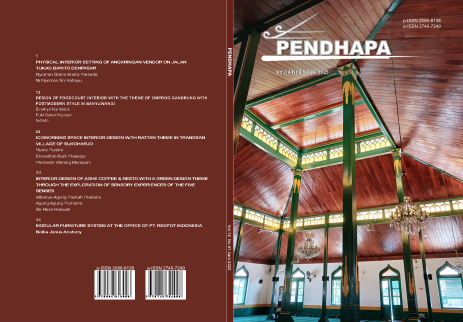Design of Foodcourt Interior with The Theme of Omprog Gandrung with Postmodern Style in Banyuwangi
Keywords:
Keywords, Interior, Foodcourt, Omprog Gandrung, Postmodern, Banyuwangi.Abstract
Foodcourt Interior Design with the Theme Omprog Gandrung with a Postmodern Style in Banyuwangi Regency supports the needs of tourists as a manifestation of the development of the tourism sector in Banyuwangi Regency and aims to be a place that is able to facilitate user needs to become an attractive, comfortable and safe place with the theme Omprog Gandrung and applying a postmodern style. The design method used is the Pamuji Suptandar Design Method Program which consists of input, analysis/synthesis, and output stages. The approach used is function, ergonomics, aesthetics, and technical. The results of Foodcourt Interior Design with the Omprog Gandrung Theme with Postmodern Style in Banyuwangi Regency are foodcourt interior designs that have foodcourt stand facilities, dining areas, souvenir shops, music stages, talent rooms, sound control rooms, customer service, offices, front office & office waiting rooms.
Downloads
References
Arief, A. R. (2005). Pengantar Ilmu Perhotelan dan Restoran. Graha Ilmu.
Ching, F. D. K. (1996). Ilustrasi Desain Interior Jakarta. Erlangga.
Dariharto. (2009). Kesenian Gandrung Banyuwangi.
Jencks, C. (1979). The Language of Post-Modern Architecture. MIT Press.
Soekresno. (2000). Management Food and Breverage. Gramedia.
Suptandar, P. (1999). Desain Interior Pengantar Merencana Interior Untuk Mahasiswa Desain dan Arsitektur. Djambatan.
W.A., M. (1991). Restaurant dan Segala Permasalahannya. Andi Offset.
Ardhana, W. A. (2018). Perkembangan Bentuk Dan Makna Motif Omprog Gandung Banyuwangi. Tugas Akhir Fakultas Bahasa Dan Seni Universitas Negeri Yogyakarta.
Dhanny, U. R. (2019). Foodcourt di Kota Pontianak. Jurnal Online Mahasiswa Arsitektur Universitas Tanjungpura, 7(1).
Esa D, P., & Firtatwentyna N, P. (2011). Pemanfaatan Pencahayaaan Alami Pada Rumah Tinggal Tipe Townhouse di Surabaya. Prodi Desain Interior Universitas Kristen Petra Surabaya.
Negara, D. A. (2012). Makna Tata Busana Tari Gandrung Banyuwangi. Jurnal Universitas Negeri Malang.
Nur, T. K. H. M., Antariksa, & Sari, N. (2010). Pelestarian Pola Permukiman Masyarakat Using di Desa Kemiren Kabupaten Banyuwangi. Jurnal Mahasiswa Fakultas Teknik Universitas Brawijaya , 2(1).
Pakarti, D., Kebayantini, N. L. N., & Aditya, A. K. (2020). Relasi Kuasa Dalam Perubahan Seni Tari Gandrung di Desa Kemiren, Kecamatan Glagah, Kabupaten Banyuwangi. Jurnal Mahasiswa Fakultas Ilmu Sosial Dan Ilmu Politik Universitas Udayana.
Rachmita Aulia, N. (2019). Gedung Pertunjukan Musik Pontianak. Universitas Tanjungpura Jurnal Online Mahasiswa Arsitektur.
https://banyuwangikab.go.id. (2022, December 17).
Kamus Besar Bahasa Indonesia. (2022, July 22).
Downloads
Published
Issue
Section
License
Copyright (c) 2023 Sinatrya Nurhaliza

This work is licensed under a Creative Commons Attribution-ShareAlike 4.0 International License.
Authors who publish with Pendhapa agree to the following terms:
- Authors retain copyright and grant the journal right of first publication with the work simultaneously licensed under a Creative Commons Attribution License (CC BY-SA 4.0) that allows others to share the work with an acknowledgment of the work's authorship and initial publication in this journal.
- Authors are able to enter into separate, additional contractual arrangements for the non-exclusive distribution of the journal's published version of the work (e.g., post it to an institutional repository or publish it in a book), with an acknowledgment of its initial publication in this journal.
- Authors are permitted and encouraged to post their work online (e.g., in institutional repositories or on their website) prior to and during the submission process, as it can lead to productive exchanges, as well as earlier and greater citation of published work.

This work is licensed under a Creative Commons Attribution-ShareAlike 4.0 International License.









